We Offer Telemedicine Appointments.
Sciatica
Pinched Sciatic Nerve
What is Sciatica?
Sciatica, also known as lumbar radiculopathy, refers to pain and other symptoms which radiate throughout the sciatic nerve. The sciatic nerve is the main nerve that branches out from the lower back and travels through the hips, buttocks, and down the legs. In sciatica, the roots of the sciatic nerve running from L4 to S3 become compressed by a herniated disk or narrowing of the spinal canal. This can cause radiating pain, weakness, and numbness through the hips and legs. If the symptoms last for eight weeks or less, this is known as acute sciatica. If the symptoms last for more than eight weeks, this is known as chronic sciatica. Sciatica is typically treated with medication, physical therapy, and heat and cold therapy. In some cases, surgery may be necessary.
The Sciatic Nerve Roots
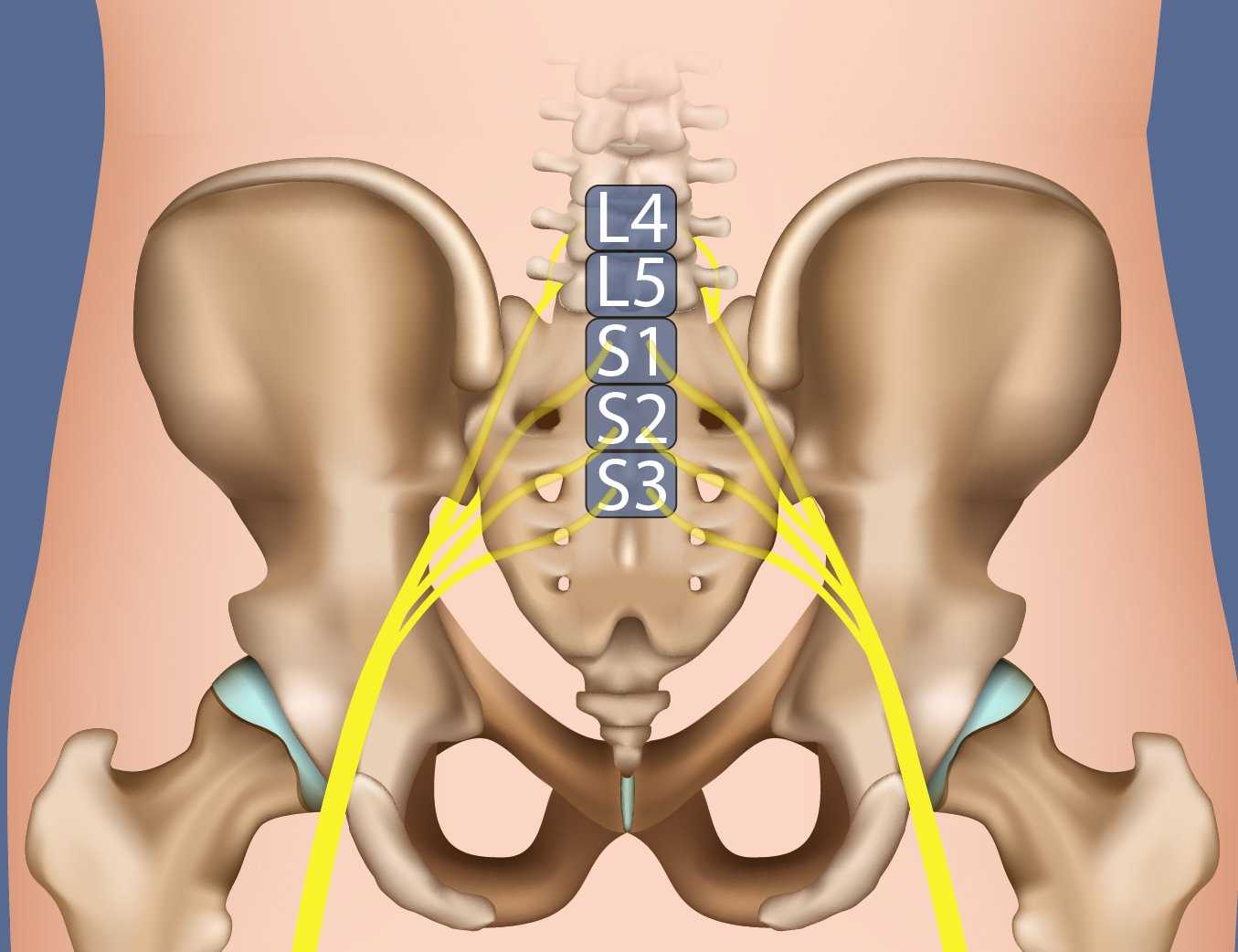
Sciatica Symptoms
Signs and symptoms of sciatica can vary widely but may include:
- Lower back pain
- Shooting leg pain
- Pain radiating from the buttocks to the feet
- Constant pain in the buttocks
- Burning or tingling pain in the hips
- Weakness or numbness in the affected leg
- Difficulty moving the affected leg or foot
- Shooting pain while standing
- Discomfort when sitting for a long time
Sciatica Causes
Several different conditions can result in the compression and irritation of the sciatic nerve causing symptoms of sciatica. Some conditions include:
Piriformis Syndrome:This is an uncommon disorder that occurs when the piriformis muscle affects the sciatic nerve. The piriformis is a small, flat muscle located behind the gluteus maximus, in the buttocks. The muscle runs through the greater sciatic foramen (the space on each inner side of the pelvic bones) to the upper surface of the femur (the thigh bone). The piriformis muscle enables the hips to rotate and helps you keep your balance. The sciatic nerve runs underneath or through the muscle, down the legs and branches off at the back of the knee into the tibial nerve and common peroneal nerve. Piriformis syndrome occurs when the piriformis muscle compresses the sciatic nerve when sitting, walking, or running.
Piriformis Muscles
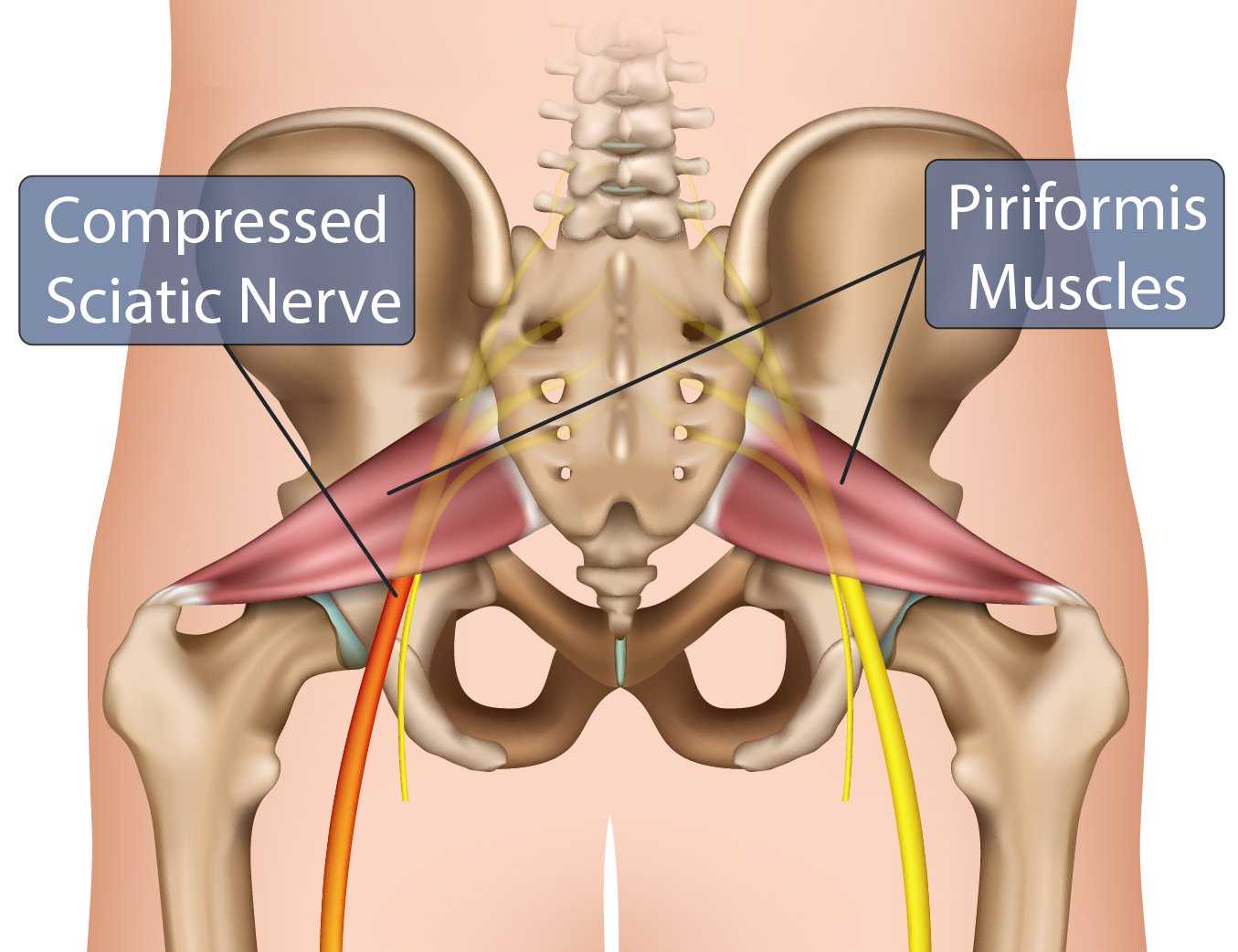
Greater Sciatic Foramen
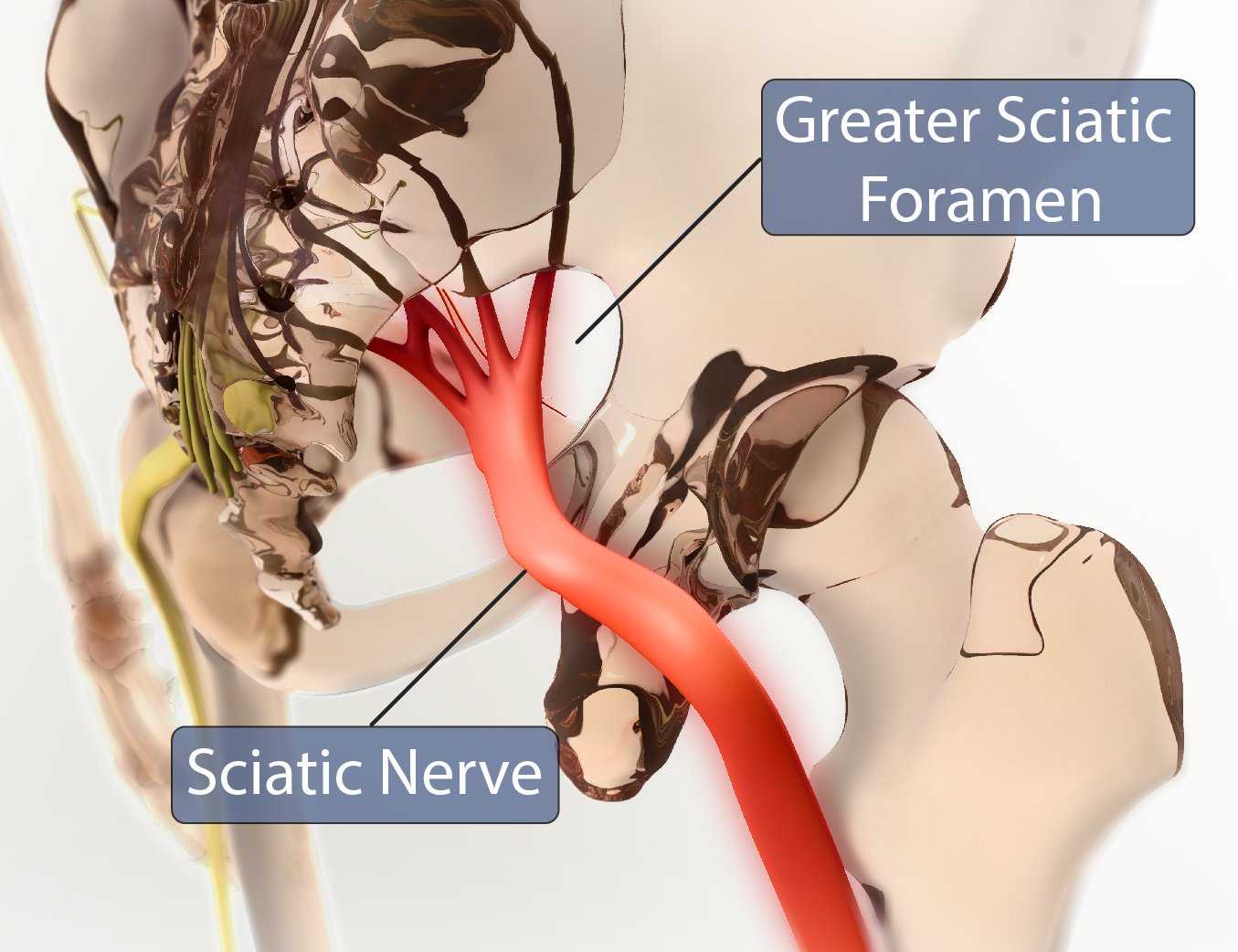
Generally, the sciatic nerve runs below the Piriformis Muscles (Type I - Undivided), however, variants can occur in which the nerve runs through, above, and below the muscle or varied combinations.
Sciatic Nerve Variations
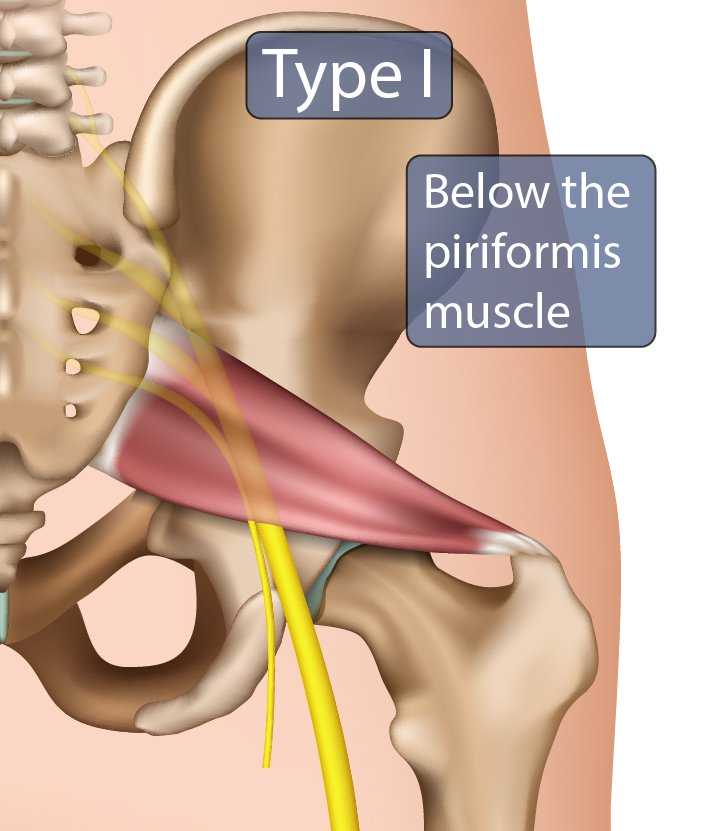
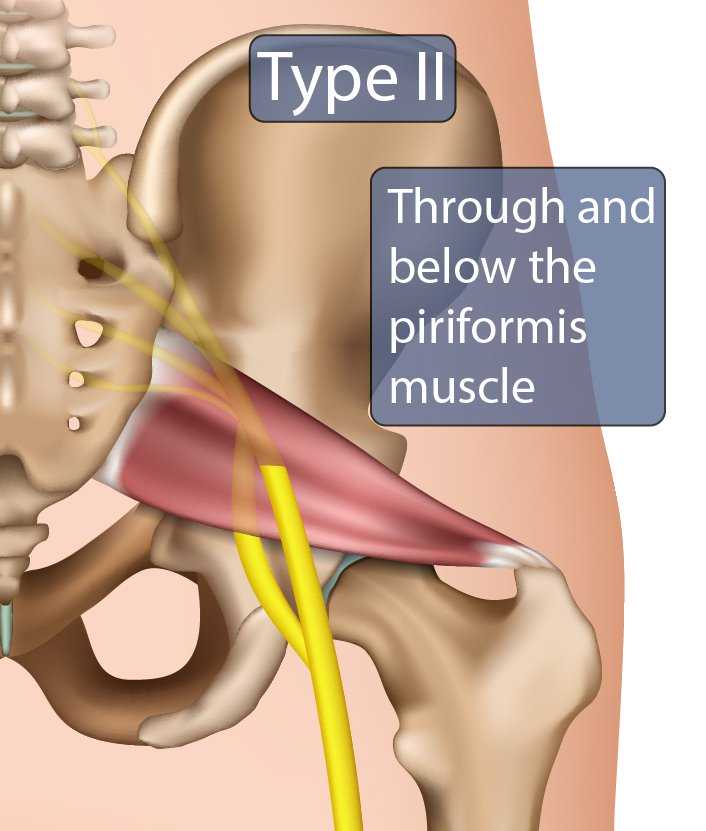
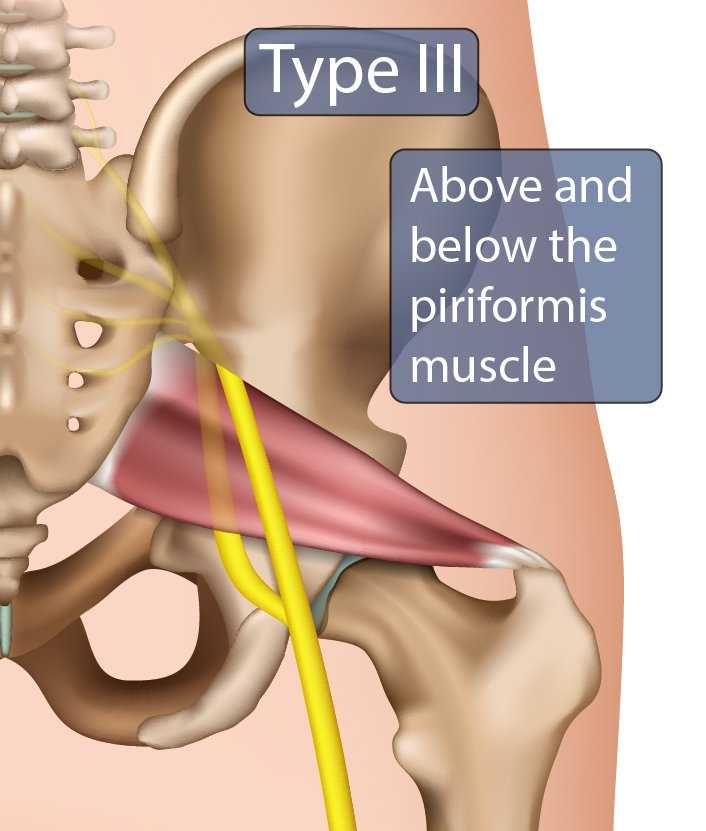
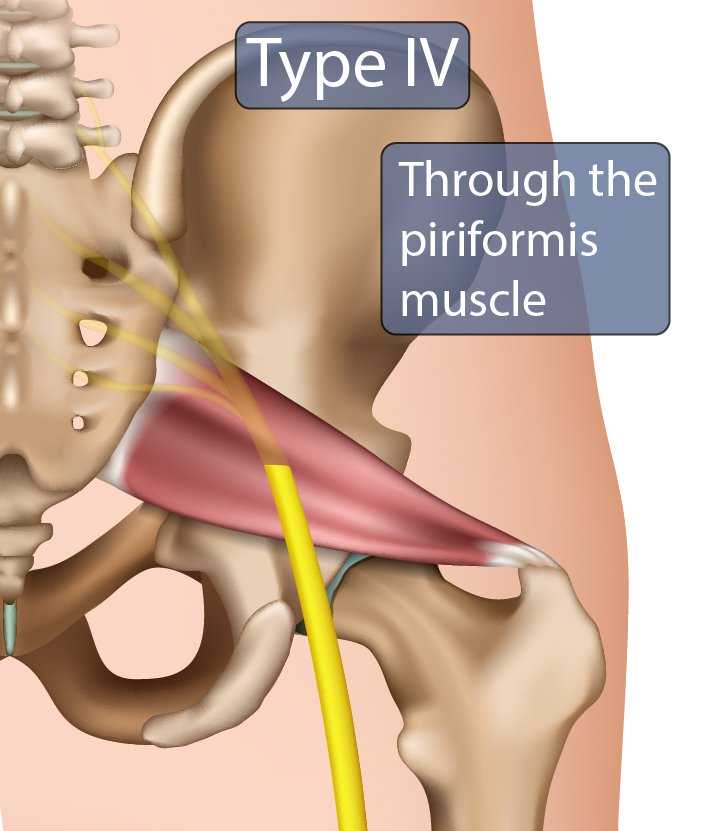
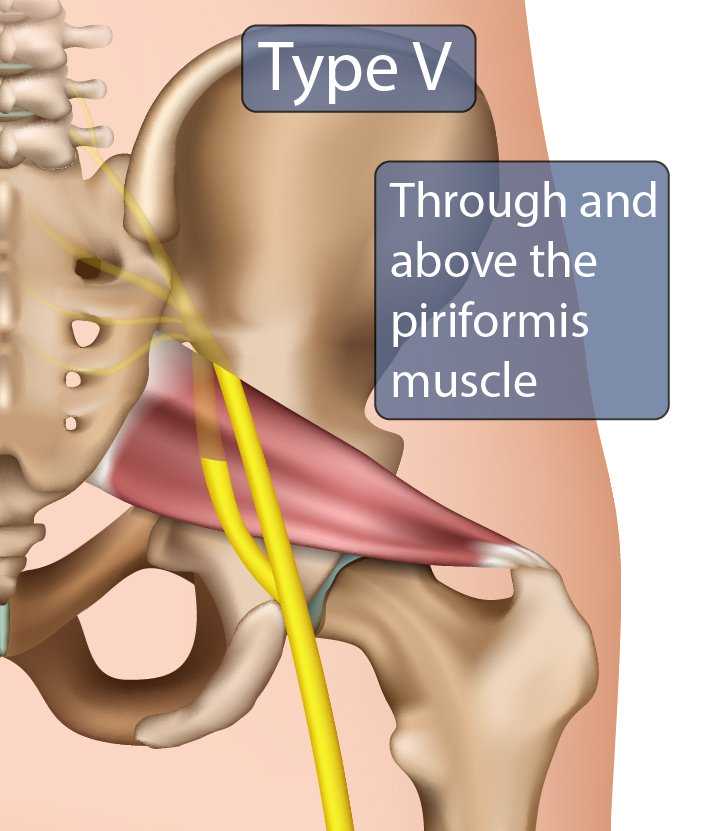
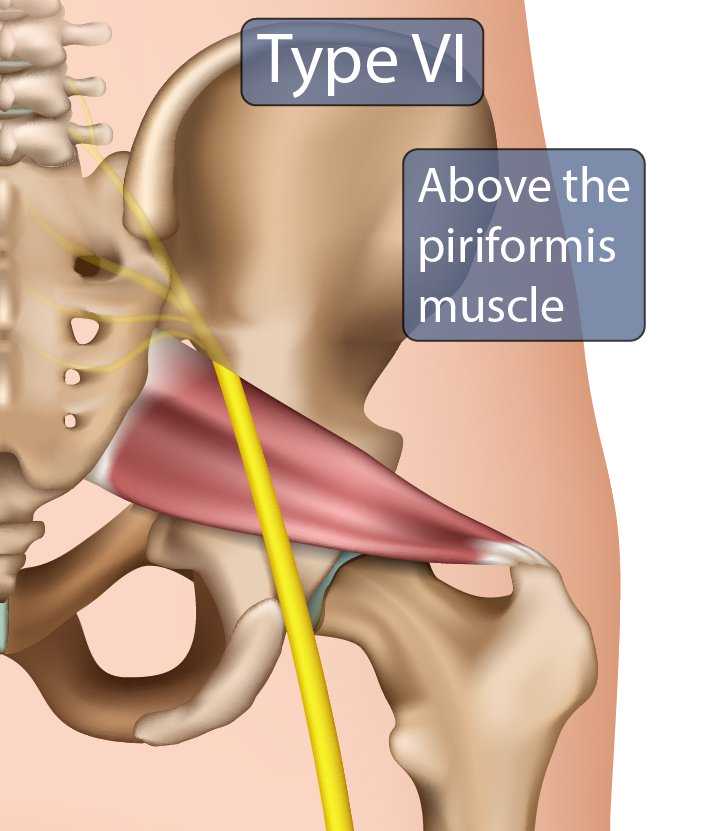
Herniated disc: A common cause of sciatica is a herniated or bulging disc. A vertebral disc is a small, round cushion with a soft inner core, covered by a tough outer layer. Each disc acts as a shock absorber and protects the bones in the spine. Sometimes, due to trauma or injury, the soft, inner nucleus of a disc can break through the outer layer. If this happens in the lumbar region of the spine (the lower back) it can cause compression on the sciatic nerve.
Normal Disc

Herniated Disc
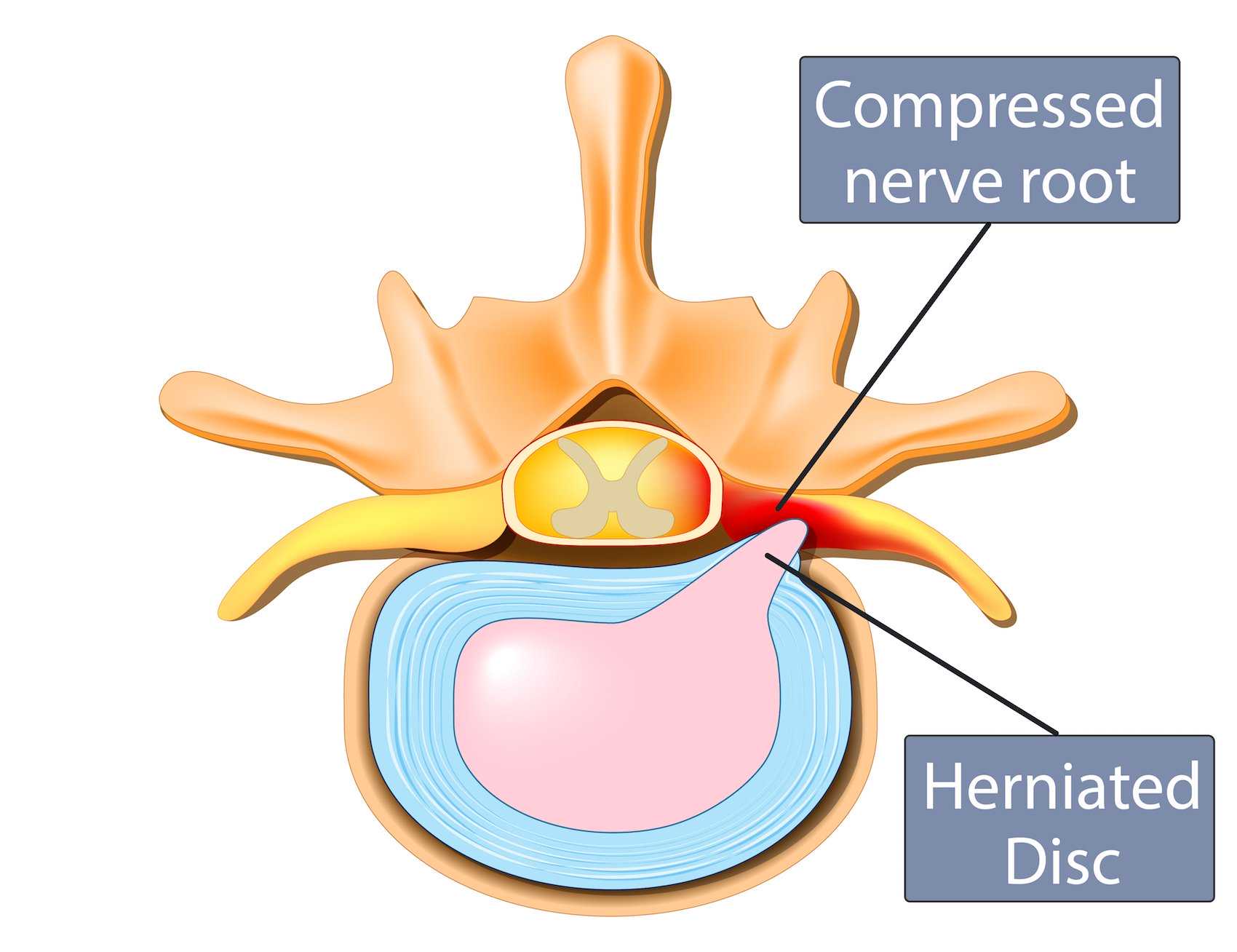
Lumbar Spinal Stenosis: The lumbar region of the spine (the lower back) is comprised of five vertebrae. Spinal stenosis involves a narrowing of the spinal canal, that compressed the nerve roots which pass through the lower back into the legs. This condition is most common in people aged 60 years and above.
Spondylolisthesis: Spondylolisthesis is a condition of the spine which affects the lumbar region (lower back). It results in slippage of one of the lower vertebrae. When the vertebra slips forward, it puts pressure on the bone beneath it. In some cases, the sciatic nerve can become compressed between the two vertebrae.
Degenerative Disc Disease: Degenerative disc disease is a broad term used to describe an array of age-related spinal conditions that are causing neuropathic pain. As we age, the intervertebral discs lose the volume of water they once had and begin to shrink and dry out which can result in thinning discs. As a result, these compressed discs are not able to insulate the vertebrae which can lead to bone on bone abrasion and the formation of bone spurs. Thinning discs can also shrink the foramen, trapping the sciatic nerve roots. Degenerative discs are also prone to cracks or tears in the annulus which can result in herniated or bulging discs that put pressure on the spinal cord or nerve roots.
Obesity: Obesity can lead to sciatica because excess body weight can put stress on the spine. This can lead to changes in the spine, such as a herniated disc or wearing of the vertebrae which can compress the sciatic nerve.
Pregnancy: Although sciatica is not strictly caused by pregnancy, some women experience sciatic pain during pregnancy. This can be due to one of the following reasons:
- Weight gain or increased fluid retention, which puts extra pressure on the sciatic nerve.
- A shifting center of gravity as the belly and breasts increase in size.
- Expansion of the uterus may compress the sciatic nerve.
- As the baby moves into the birth position, his or her head may press on the sciatic nerve
Sciatica Risk Factors
Risk factors for Sciatica include:
- Aging: Age-related changes in the spine which may increase the risk of sciatica include bone spurs and bulging or herniated discs.
- Occupation: Jobs which necessitate lifting or carrying heavy loads, repetitive twisting of the back or long period of driving may increase the risk of sciatic pain.
- Diabetes: This condition increases the risk of nerve damage, which may cause sciatica.
- Menopause: Some women may experience bone loss (osteoporosis) during menopause which may result in degeneration of the vertebrae and sciatic pain.
- Prolonged sitting: Individuals who have a sedentary lifestyle or a job which involves sitting for long periods are more likely to develop sciatica than more active people.
- Genetics: Hereditary conditions of the spine, such as scoliosis, can lead to sciatica.
Sciatica Diagnosis
After discussing your medical history and your symptoms, our doctor will give you a physical examination. This will involve checking your reflexes and the strength of your muscles. Our doctor may ask you to lie down and raise each of your legs, walk on your toes, or stand up from a squatting position. Our doctor may also order one or more of the following imaging tests:
- X-ray: An X-ray of your spinal column will highlight any bone spurs which may be compressing the sciatic nerve.
- Magnetic Resonance Imaging (MRI): An MRI will produce detailed images of your spine and will reveal any issues such as herniated or bulging discs.
- Computed tomography (CT scan): A CT scan will show any damage to your vertebrae or discs.
- Electromyography (EMG): This test is used to measure electrical impulses within the nerves and how your muscles respond to them. It is used to diagnose nerve compression caused by spinal stenosis or herniated discs.
Treatment of Radiculopathy
The aim of sciatica treatment is to relieve pain and increase mobility. Sciatic nerve pain treatment may involve non-surgical or surgical options depending on how severe the pain is.
Non-Surgical Options for Sciatic Nerve Pain Relief
Our doctor may prescribe medications for your sciatica pain. These may include:
- Anti-inflammatories: Non-steroidal anti-inflammatories (NSAIDs) such as Ibuprofen are a first line treatment for sciatic pain. They work by inhibiting your body’s production of prostaglandins, which trigger pain and inflammation.
- Muscle relaxants: If NSAIDs don't work, our doctor may prescribe muscle relaxing medication to relieve musculoskeletal pain.
- Opioids: If your back pain is severe, our doctor may prescribe a stronger prescription medication such as Vicodin or OxyContin. These drugs interact with nerve cells in the brain and body to relieve pain.
- Tricyclic antidepressants: Our doctor may prescribe certain tricyclic antidepressants, such as Cymbalta, which can help you manage sciatic pain.
- Steroid injections: In some cases, our doctor may prescribe corticosteroid injections to the affected sciatic nerve root. This type of medication relieves pain by reducing inflammation around the compressed or irritated nerve.
- Physical therapy: Once the medication is working and you have found relief from pain, our doctor may refer you to a physical therapist. The physical therapist will create a rehabilitation program that will help you regain normal mobility and by correcting your posture and strengthening your muscles, help prevent future sciatic injuries.
Sciatica Surgery
Typically, sciatica surgery is only an option when leg pain or weakness has worsened over time and medications are not providing relief. The type of surgery will depend on the underlying cause of the conditions and what part of the nervous system is being compressed (nerve roots, sciatic nerve, spinal cord, or cauda equina).
Microdiscectomy: If a herniated or bulging disc is compressing a nerve root one procedure that can provide relief from sciatic nerve pain is microdiscectomy. Microdiscectomy is a minimally invasive procedure, the aim of which is to remove the portion of the vertebral disc that is compressing the sciatic nerve.
You will be given a general anesthetic and will lie face down on the operating table. The surgeon will make a small incision in your back above the affected disc. The surgeon will then remove a small piece of the bone that protects the nerves. The damaged disc tissue is then removed to alleviate pressure on the nerve. The surgeon will then suture the incision.
You will be discharged from hospital within 24 hours. You will have an appointment with a physical therapist who will explain how to move, stretch, and exercise to strengthen your muscles and avoid further injury. After surgery, you should avoid heavy lifting, sitting for long periods of time, and you may need to reduce your workload for the first two weeks. You should make a full recovery within six weeks.
Lumbar Stabilization: If sciatica is being caused by a slip in the vertebrae (spondylolisthesis) surgical treatment would involve implanting a lumbar stabilization device. Spondylolisthesis can constrict the cauda equina or nerve roots causing sciatic pain. A lumbar stabilization device, inserted between the spinous process of the affected vertebrae, will align the vertebrae, provide stability, and maintain foraminal height.
Foraminotomy: If an obstruction in the foramen (the tunnels on either side of the vertebrae that the nerve roots pass through) such as a bone spur is causing compression of a nerve root, a foraminotomy is the best surgical option. A foraminotomy involves enlarging the foramen by removing bone, tissue, or other materials that are pressing on and damaging the nerve root.
Laminectomy/ Laminoplasty/ Laminotomy/ Hemilaminotomy: If compression of the cauda equina or nerve root is caused by a narrowing of the spinal canal (spinal stenosis) procedures such as laminectomy, laminoplasty, laminotomy, and hemilaminectomy can be used to enlarge the spinal canal.
Laminectomy
Removal of the entire lamina, the posterior portion of the vertebra in which the spinal cord and cauda equina runs through.

Laminoplasty
The removal of one laminae, hinging the remaining laminae and structure open, and implanting a device that hold the enlarged structure in place.

Laminotomy
Removing a portion of laminae from two adjacent vertebrae.

Hemilaminectomy
Removing a portion of the laminae of one vertebra.

At Miami Neouroscience Center we help patients with Sciatica using the latest techiques and treatments, contact us today.
Sciatica Alternative Medicine
The following forms of alternative medicine may be helpful for relieving symptoms of sciatica.
Acupuncture
Acupuncture can help to relieve sciatic pain as a complement to or replacement for pain relief medications. An acupuncturist inserts very fine needles into specific sites on the body relating to the sciatic nerve. The insertion of the needles is intended to trigger a response within the nervous system. In turn, the brain releases endorphins (natural pain killers), stimulates blood flow to the sciatic nerve and surrounding muscles and relaxes the treated area.
Massage
Massage therapy can be an effective means of pain relief, particularly from sciatic pain. A massage can help sciatica by relaxing tense muscles and preventing them from putting extra pressure on the nerve roots. A soft tissue massage can also promote the release of endorphins and ease pain. You should avoid deep tissue massage if you have sciatica, as this may increase pressure on the nerve.
Chiropractor for Sciatica
Chiropractic therapy is a hands-on method of adjusting the spine to realign the posture and take pressure off the vertebrae. By using gentle manipulation, a chiropractor may be able to relieve sciatic pain. Although spinal adjustments are the foundation of chiropractic care, often, chiropractors also use other techniques to treat sciatica. These may include:
- Heat/cold therapy: This type of therapy helps to ease pain by reducing inflammation.
- Ultrasound therapy: This therapy uses sound waves to create gentle heat. The heat can penetrate tissues and as it does so, it improves circulation, relaxes muscles, reduces inflammation, and stiffness.
Sciatica Prevention
You can avoid sciatic injury and pain by maintaining the following practices:
- Kinetic lifting: To avoid injury when lifting objects, you should always bend your knees and lift the object with your back straight. Always hold the object close to your chest.
- Avoid smoking: Smoking tobacco can increase the degeneration of vertebral discs.
- Improve your posture: When you’re standing or sitting, always maintain a good posture. This will help you to avoid excessive stress on your back.
- Exercise regularly: This will help you to strengthen your body’s core, which stabilizes your whole body.
- Move around: Avoid sitting down for extended periods of time.
Sciatica Stretches and Exercises
If you’re suffering from sciatic pain, certain exercises can help you loosen up your spine and relieve pressure on your sciatic nerve. The following four exercises are low-impact and may help relieve your pain.
The Upward Pelvic Tilt

The Upward Pelvic Tilt
The aim of the upward pelvic tilt is to strengthen the muscles in the lower abdomen and stretch the lumbar spine.
- Lie on your back on the floor.
- As you exhale, pull in your abdominal muscles as tightly as you can while pressing your lower back into the floor.
- Hold the tilt for five second then relax.
- Repeat ten times.
Alternate Knee to Chest
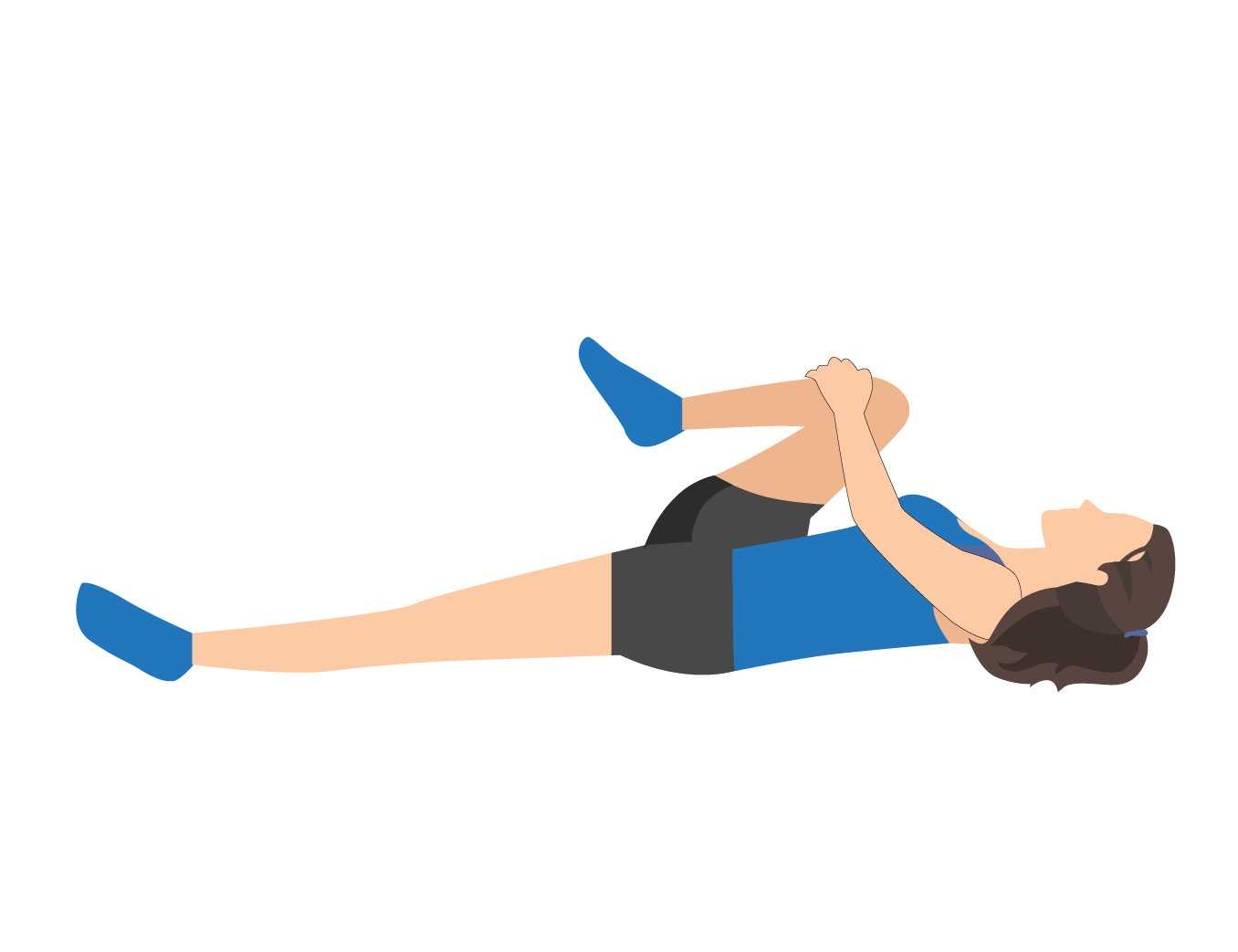
Alternate Knee to Chest
The aim of the knee to chest exercise is to decompress the sciatic nerve in your lower back, which should help ease the pain.
- Lie on your back on the floor.
- Grasp your right knee and gently pull it to your chest.
- Hold for 10 seconds.
- Repeat this movement with your left knee.
- Hold for 10 seconds.
- Perform the movement with alternate knees five times each.
Press Up/ Push Ups

Press Up/ Push Ups
The aim of the press up is to flex the back, stretch the spine, and release pressure from the sciatic nerve.
- Lie on your stomach on the floor.
- Position your forearms on the floor with your elbows under your shoulders.
- Raise your chest from the floor, extending your spine from your neck to your coccyx
- Hold the position for 30 seconds, breathing evenly.
- Lower your chest to the floor.
- Repeat 10 times.
Figure Four
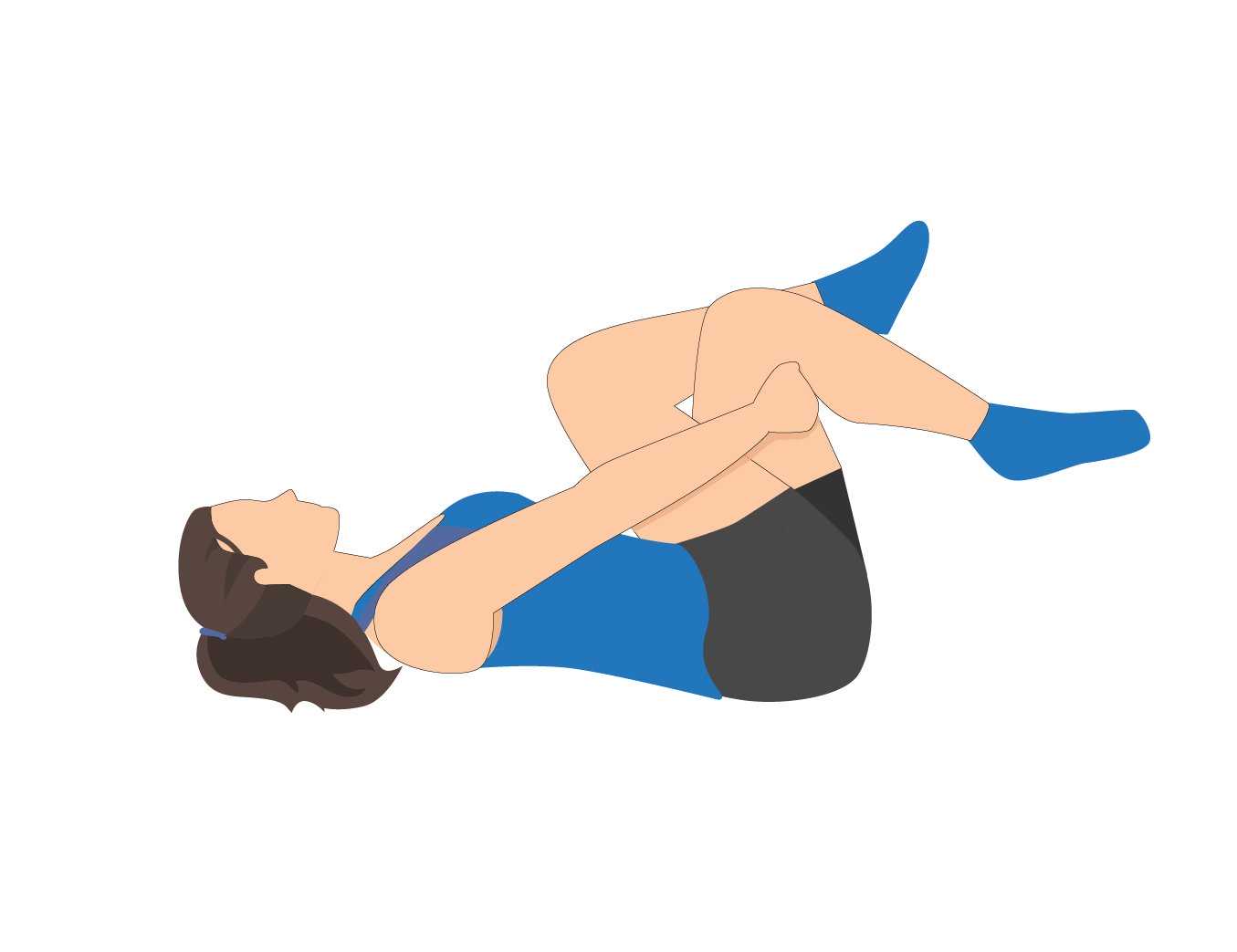
Figure Four
The aim of this exercise is to flex the pelvis and legs and relieve pressure from the sciatic nerve.
- Lie on your back on the floor.
- Bend your knees and place your feet flat on the floor.
- Cross your right ankle over your left knee (forming a figure four)
- Grasping your left knee, gently pull your leg to your chest as you push your right knee away.
- Hold for 20 seconds.
- Switch legs and repeat 10 times.
FAQ - Frequently Asked Questions
Sciatica may be acute or chronic. Acute sciatica can last between one and two weeks. Chronic sciatica can flare up on a regular basis, though the pain tends to be less severe than in acute sciatica.
Several things can trigger sciatic pain. These include wearing high heels, being overweight, sitting for long periods of time, wearing tight jeans, and excessive stress.
Sleeping with sciatica can be uncomfortable. The most comfortable way to sleep with sciatica is to lie on your back with a pillow behind your knees so they are slightly bent towards the ceiling. Sleeping on a firm mattress can also make you more comfortable. Taking a warm bath before bed will help your muscles to relax.
Sciatic nerve pain location can vary. You may feel it in your lower back, your buttocks, radiating down your legs, or one or more of these locations.
Around 2.2% of the U.S. population experience sciatica each year.
In most cases, sciatica can be cured with medication and or physical therapy without the need for surgery. In severe cases, the underlying cause of sciatica, such as a herniated disc, can be resolved with surgery.
Resources
Mayo Clinic, "Sciatica", September 2019. https://www.mayoclinic.org/diseases-conditions/sciatica/diagnosis-treatment/drc-20377441
HealthCMi (Healthcare Medicine Institute), "Acupuncture Relieves Sciatica, Reduces Inflammation", October 2015. https://www.healthcmi.com/Acupuncture-Continuing-Education-News/1535-acupuncture-relieves-sciatica-reduces-inflammation
B W Koes; M W van Tulder; W C Peul, MD, "Diagnosis and treatment of sciatica" NCBI (National Center for Biotechnology Information), June 2007. https://www.ncbi.nlm.nih.gov/pmc/articles/PMC1895638/
To see if you have a Sciatica and to learn more about your treatment options please call us at 786.871.6856 or schedule a consultation today!